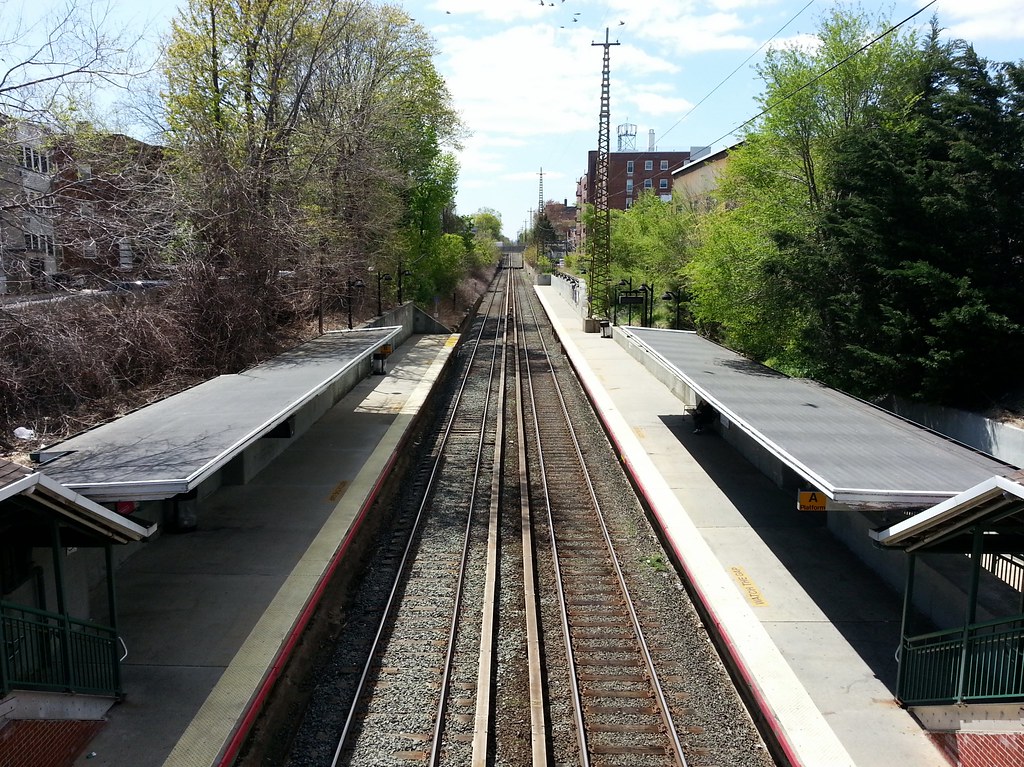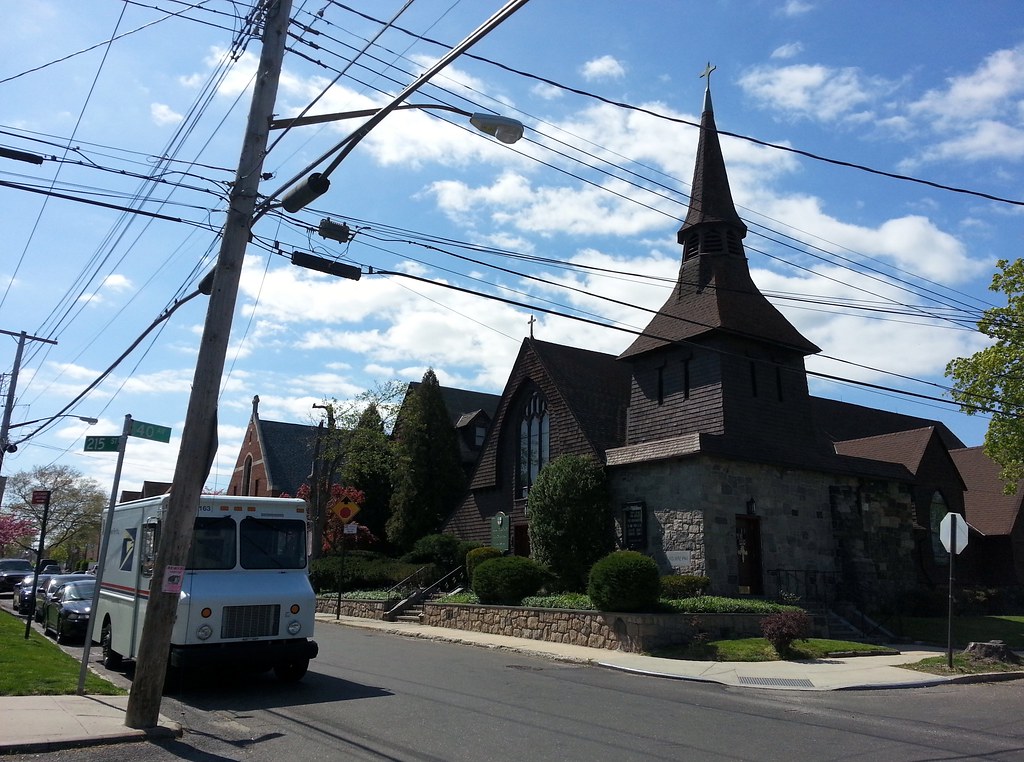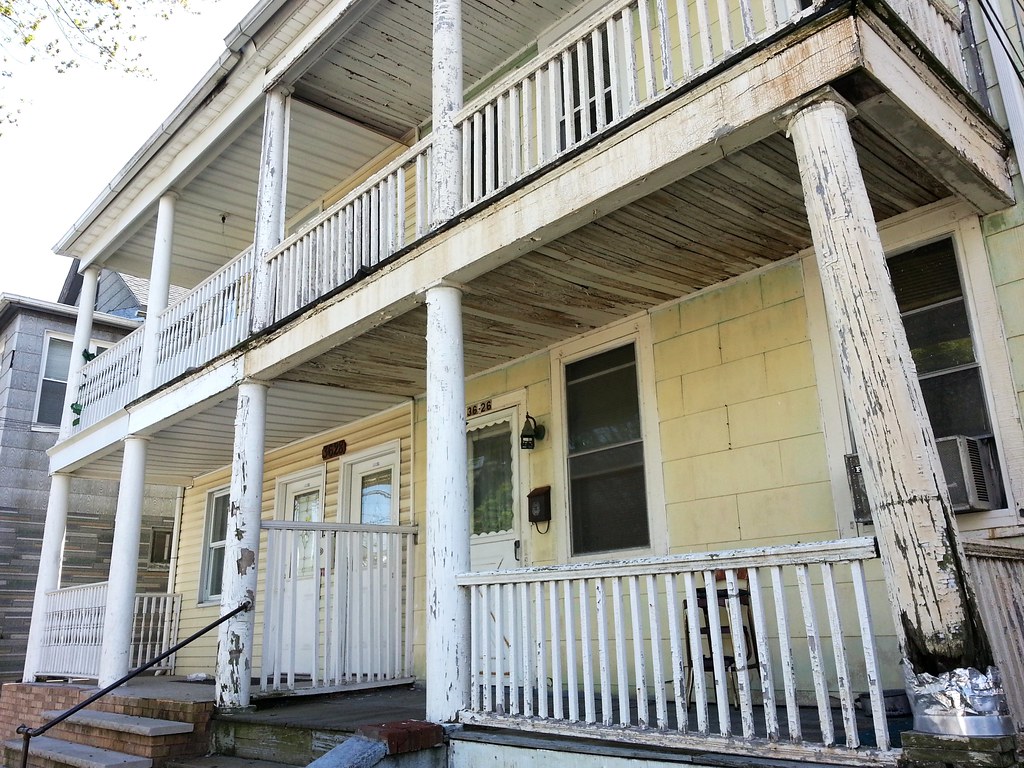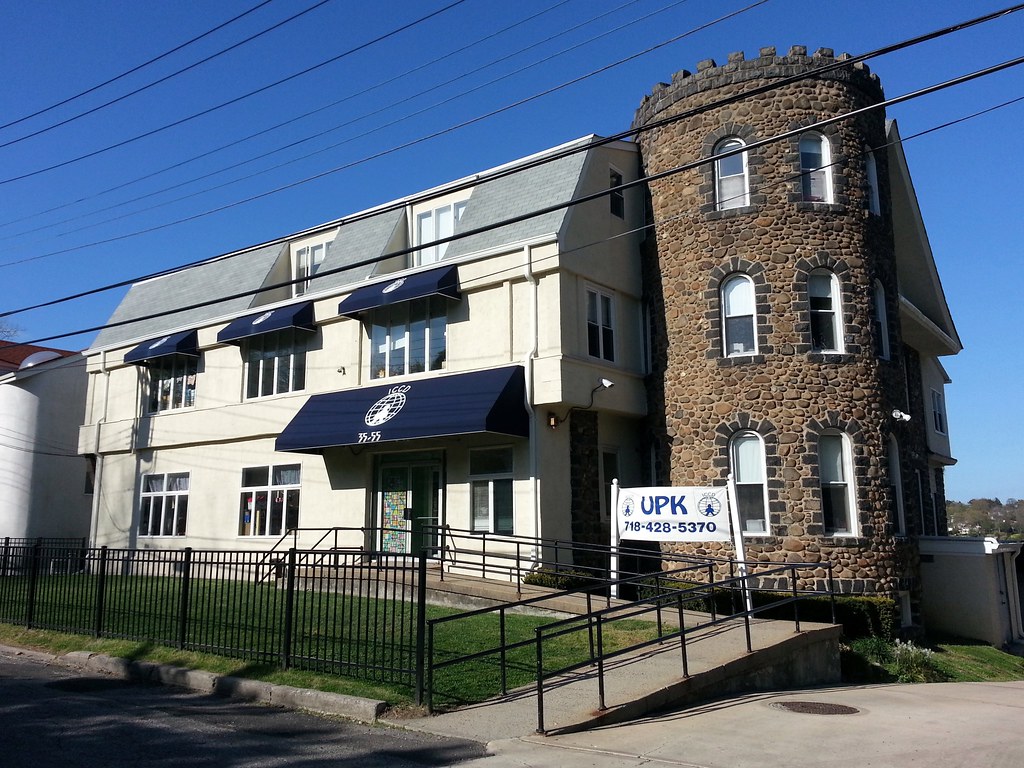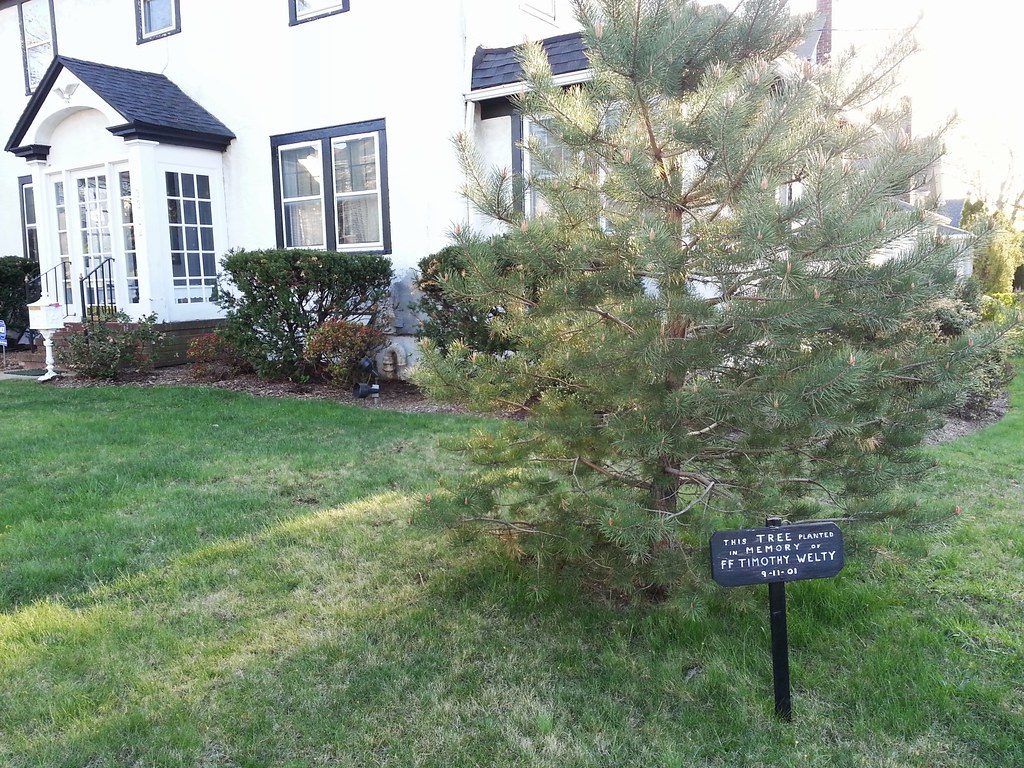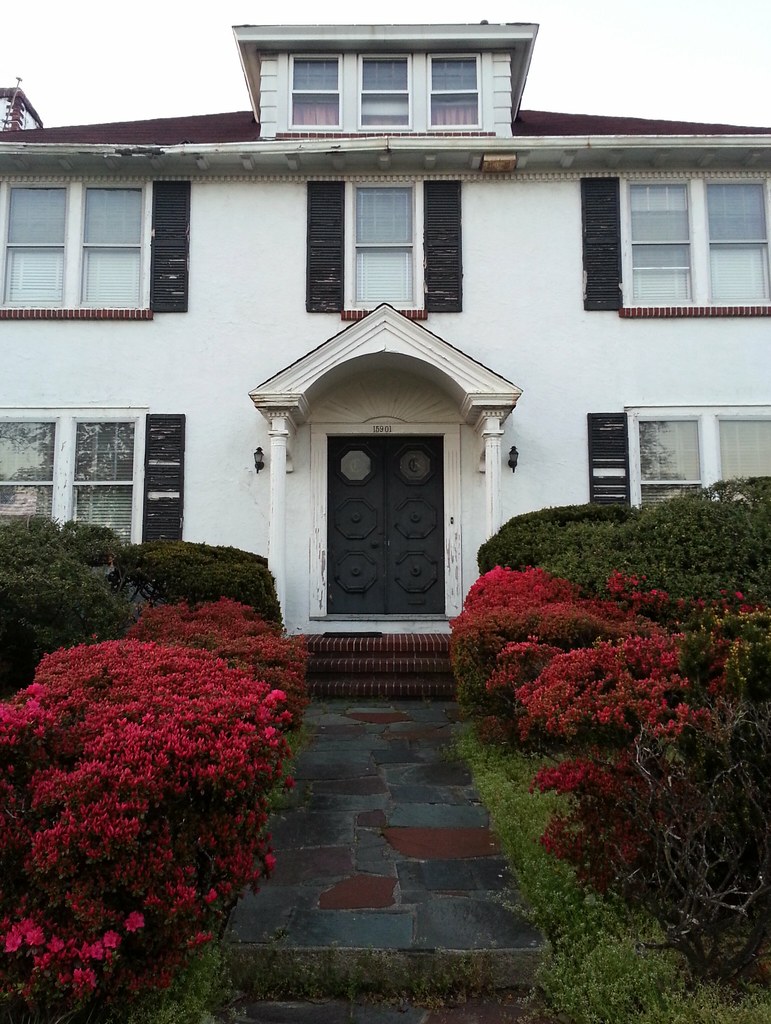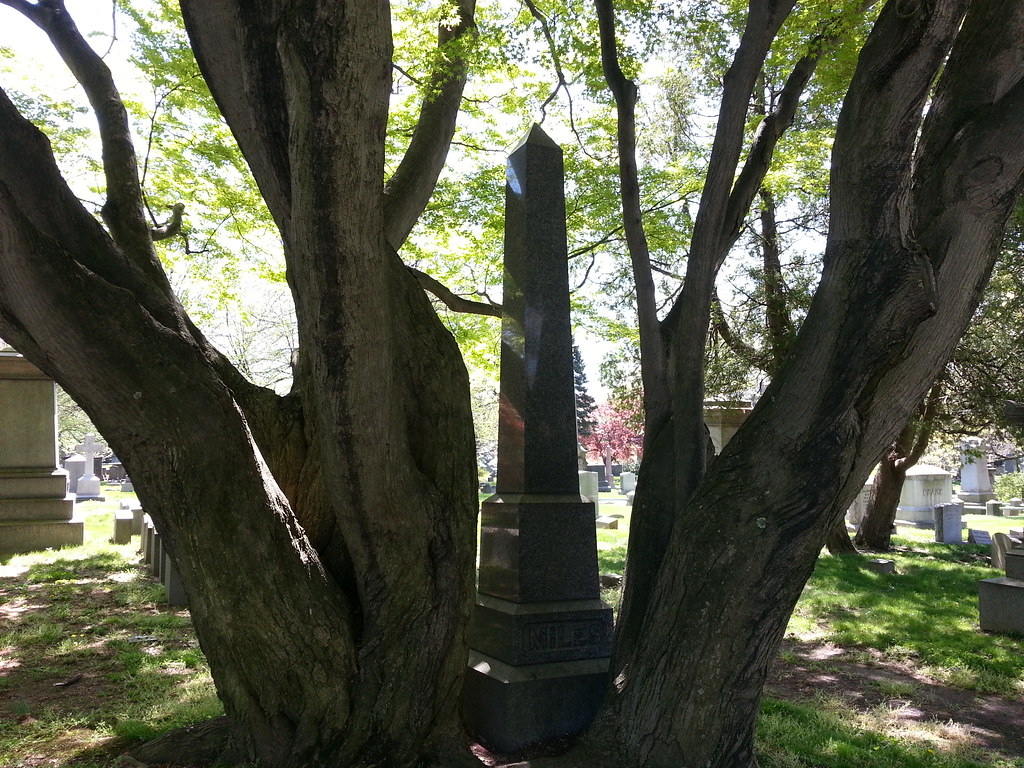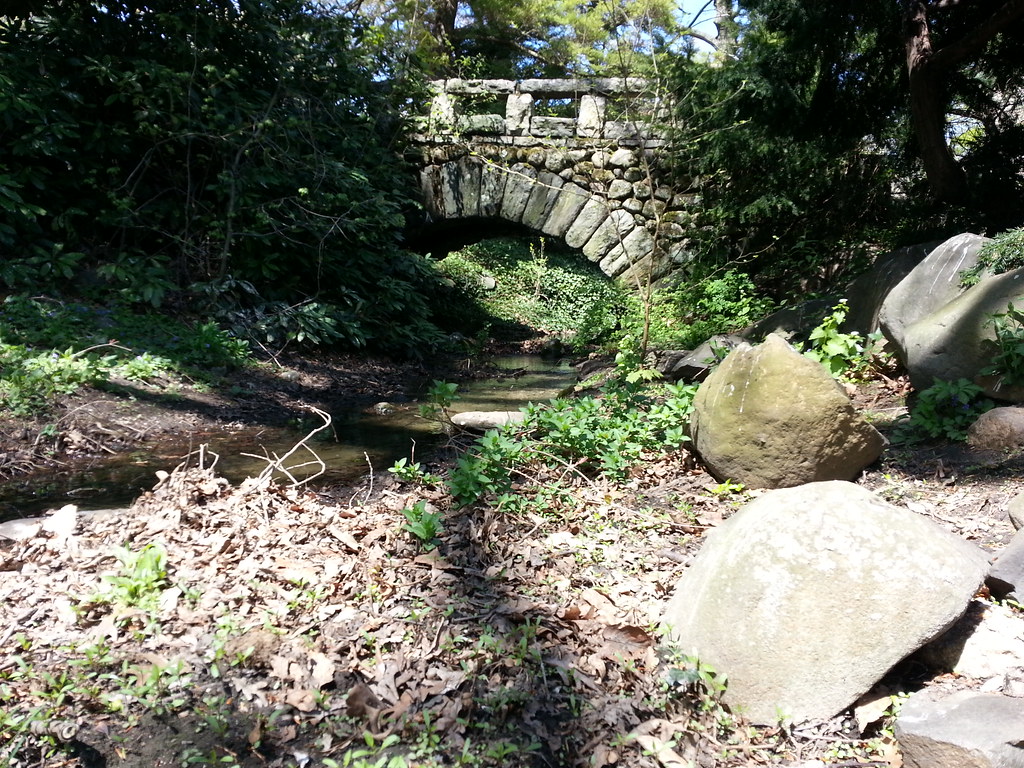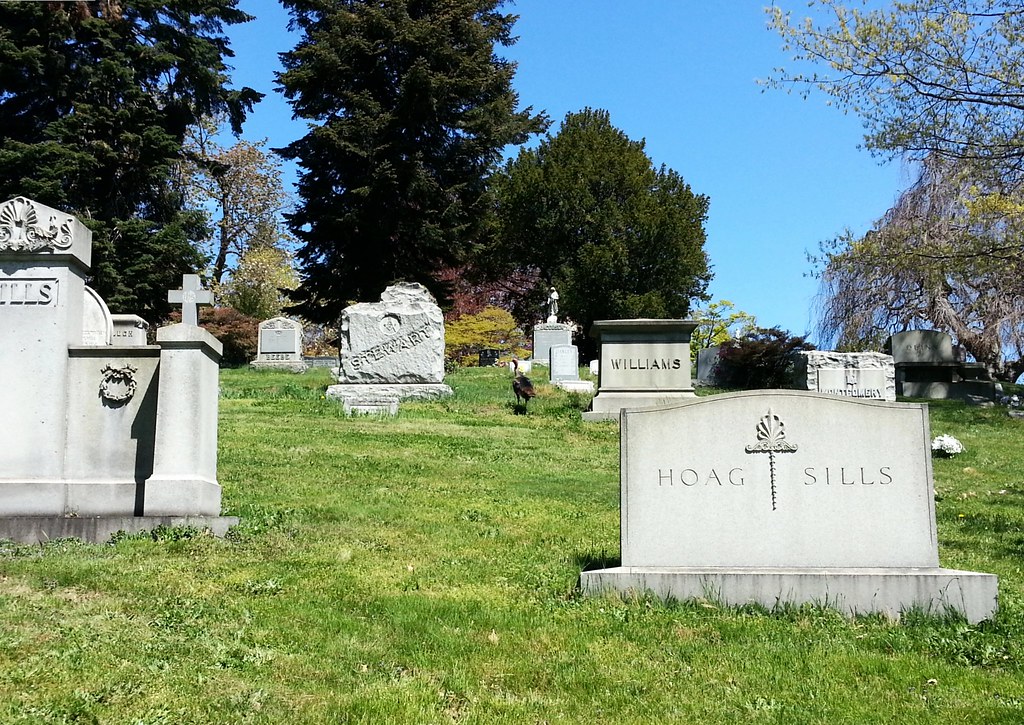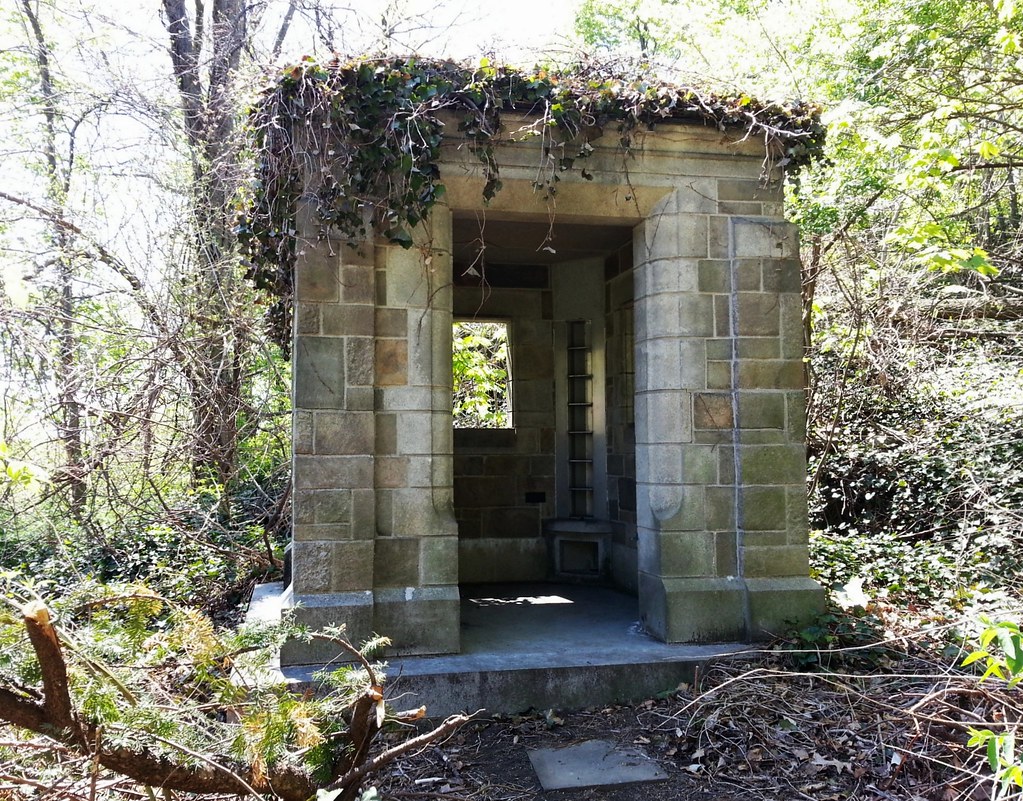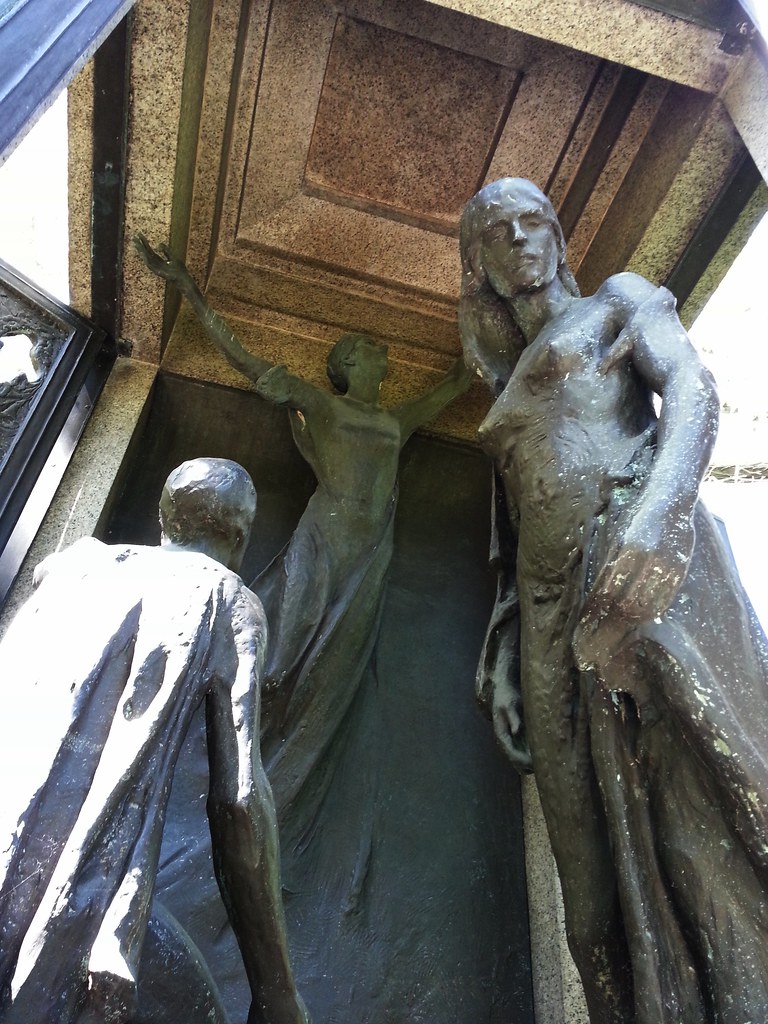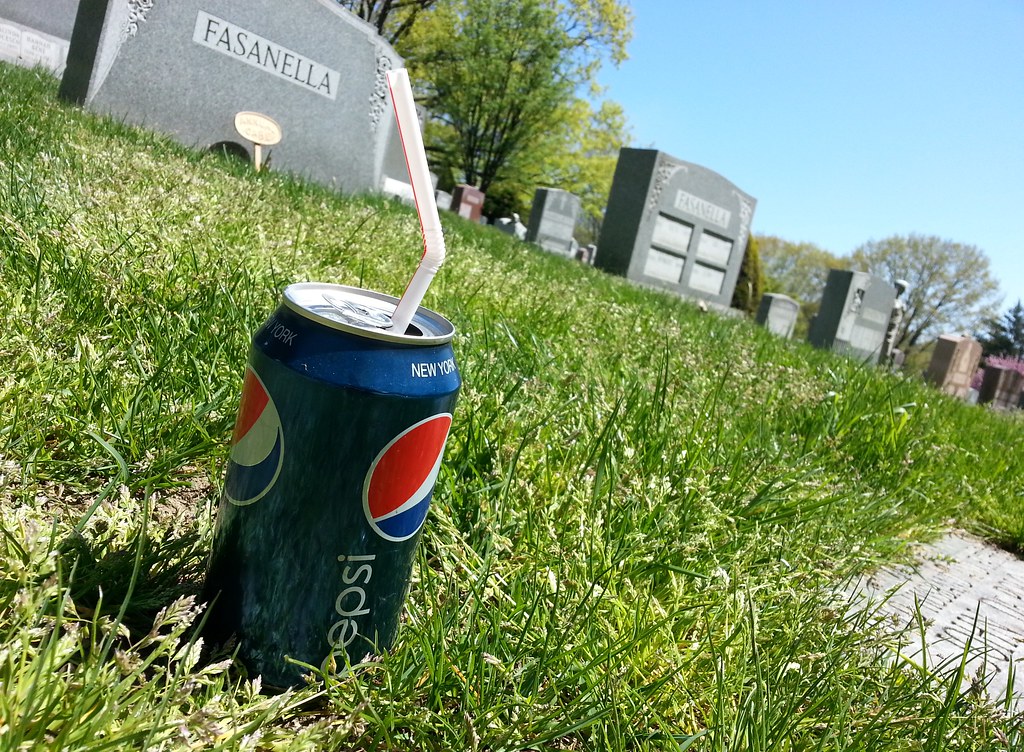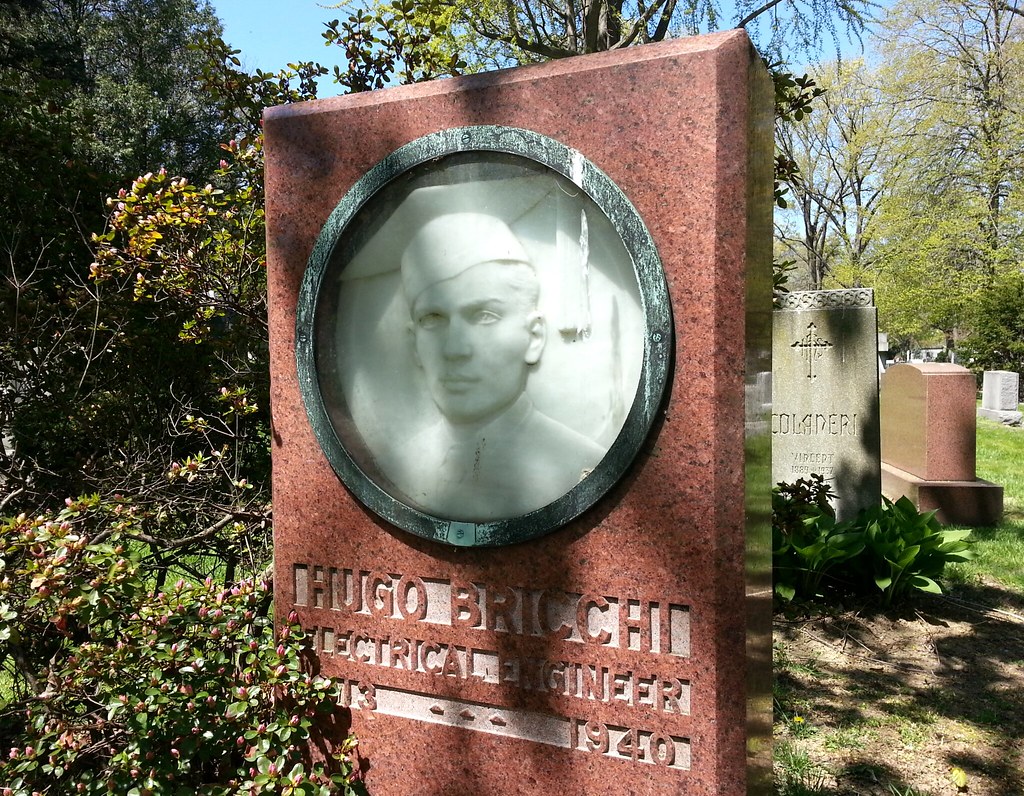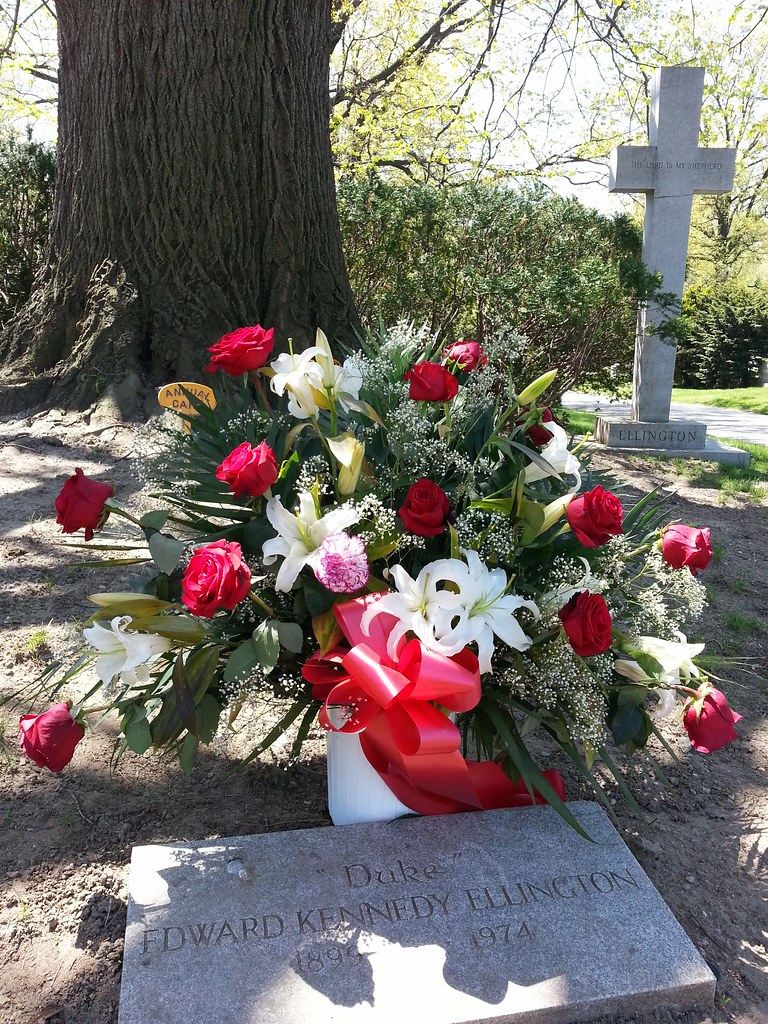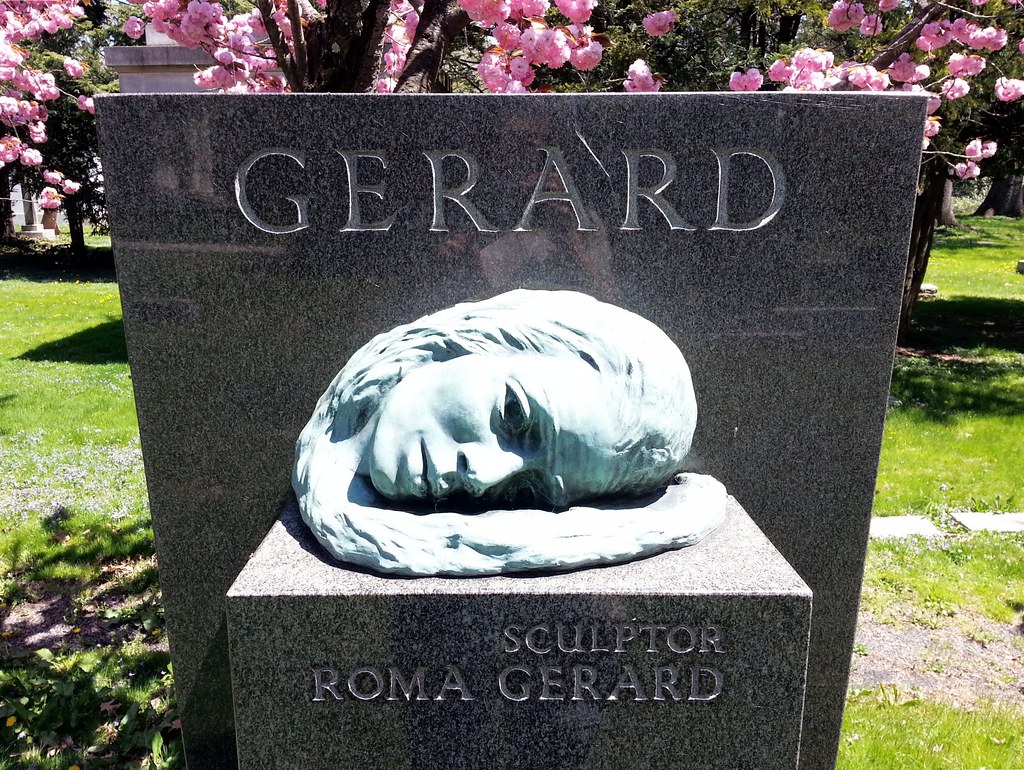

Love locks, perhaps, on the way to Little Neck Bay

and, way off in the distance, the skyline of New Rochelle
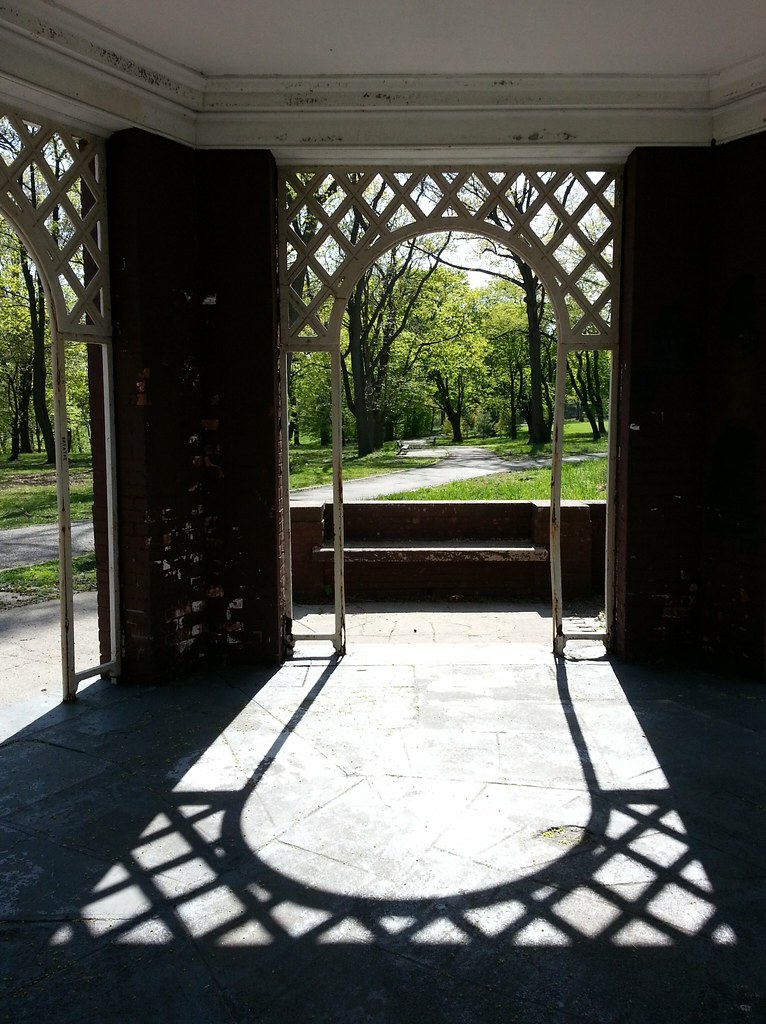
This gazebo stands atop Crocheron Park, the former site of the Crocheron House, a favorite hangout of Boss Tweed and once "one of the most famous hotels on Long Island".
Seamlessly connected to Crocheron Park is John Golden Park. Mr. Golden was a prominent Broadway producer, and, according to the Parks Department:
He and his wife Margaret moved to Bayside in 1920 and subsequently made their estate available to the community. The well-maintained grounds were often used by neighborhood residents, including golf caddies practicing their swings, little leaguers playing baseball, and Sunday picnickers walking among the gardens. Some Bayside residents remember seeing Golden strolling in his white suit, broad-rimmed hat, and spats, carrying a silver-handled cane.
Upon his death on June 17, 1955, Golden’s will bequeathed his Bayside estate to the City of New York as a park "for the use and enjoyment by the young people of the community of all races and creeds in a manner similar to that in which I made this property available for recreation and community acts during my lifetime."
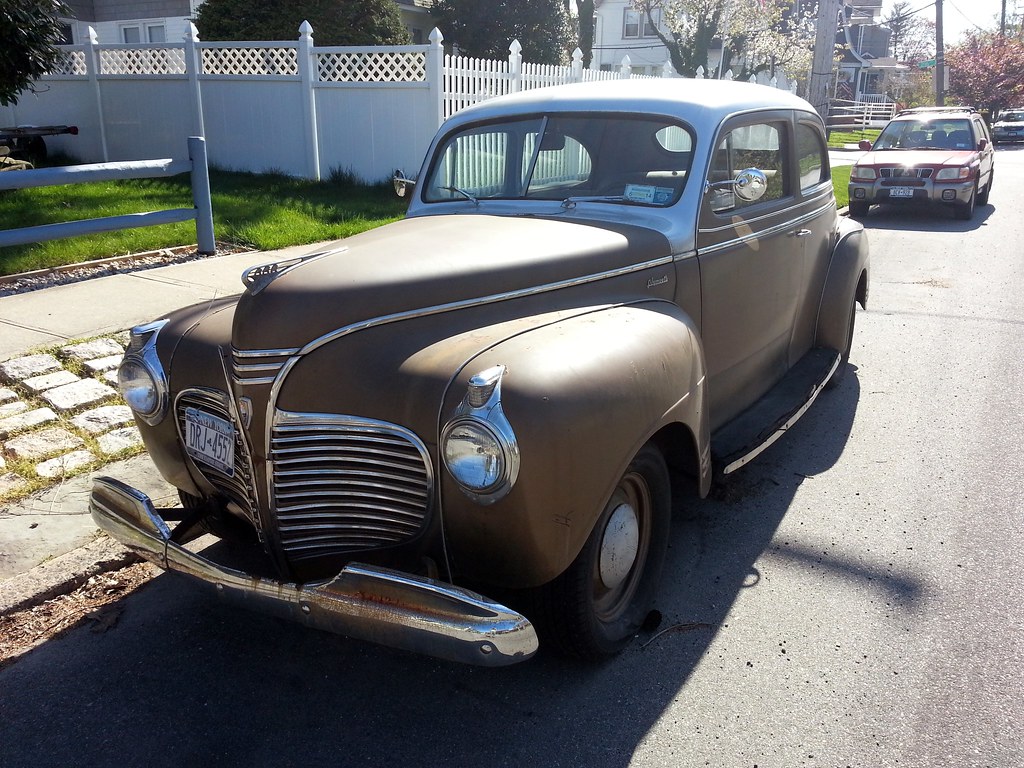
We've already seen the sedan; here's the coupe.
This car was parked along Corbett Road, which takes its name from Gentleman Jim Corbett, a former resident. He wasn't the only famous inhabitant of this street, however. According to Forgotten New York:
In the 1910s Bayside became a film actors’ colony until the nascent industry decamped to Hollywood. The Famous Players-Lasky Corporation built studios in Astoria that still stand today, and Bayside joined South Greenfield, Brooklyn as a filmmaking hotbed, with D.W. Griffith, in particular, filming hundreds of productions. Corbett Road became a favorite spot for stars to make their homes, with W.C. Fields, Norma Talmadge and John Barrymore all living along the scenic way overlooking Crocheron Park. Years after the film industry moved to California, Paul Newman resided on Corbett as well.

Once a family picnic ground known as Pine Grove, this little cemetery hard by the LIRR's Port Washington Branch (the steps in the foreground lead up to a pedestrian bridge over the tracks) is the final resting place of several notable members of the Lawrence clan, including Cornelius Van Wyck Lawrence, a former mayor of NYC.
(For the record, this is the second Lawrence Cemetery we've visited in Queens; the first was in Astoria.)

...out of a DeLorean?
(Check out the windshield.)

That's a Wiard walking plow. Check out this hilarious old ad from the company.
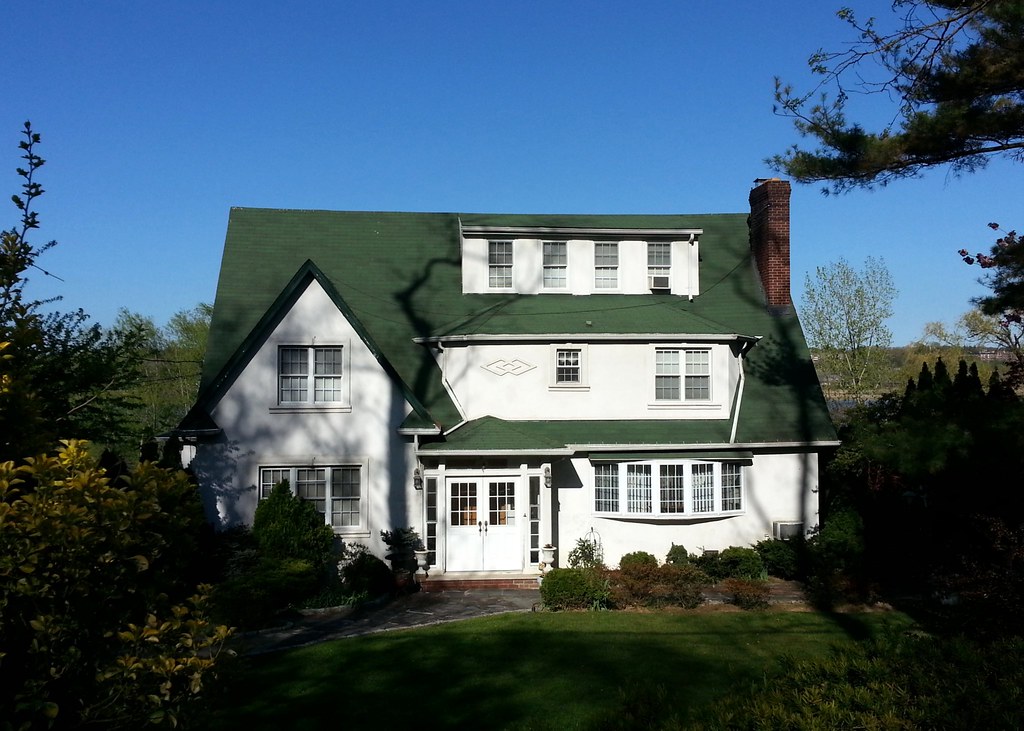
Running along the eastern edge of Bayside, 223rd Street, formerly home to W.C. Fields, is lined with massive homes overlooking Little Neck Bay.
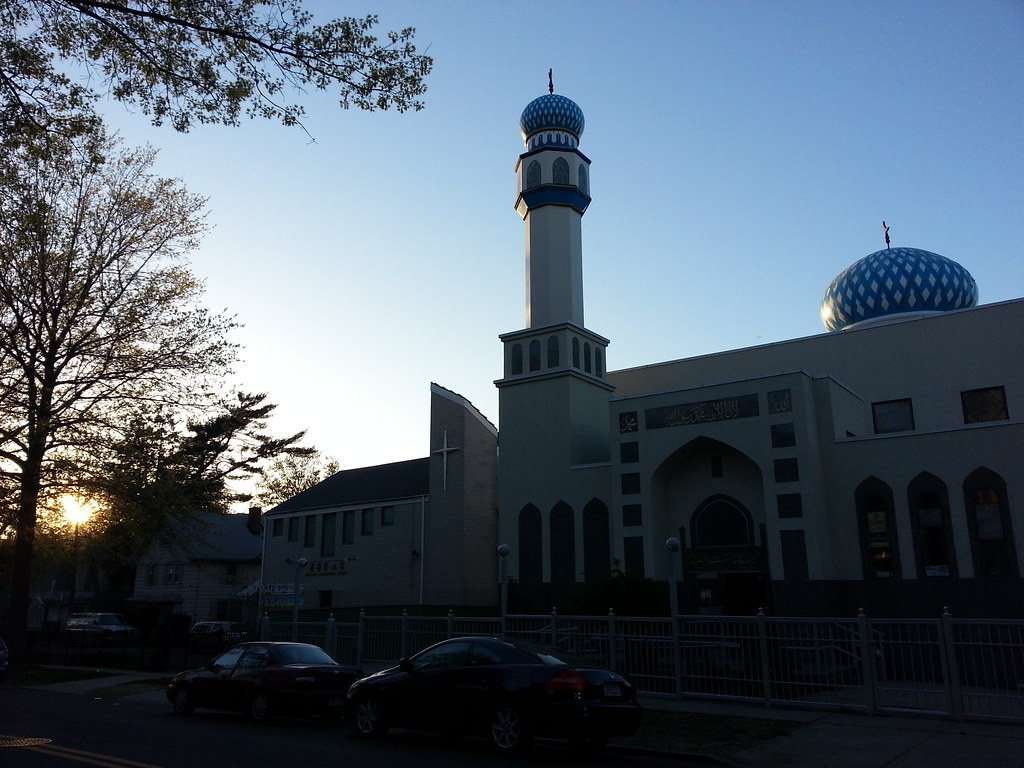
A Korean church and an Afghan mosque in Flushing, the cradle of religious freedom

Founded in 1863 in what is now the Bronx, Woodlawn comprises 400 acres of spectacular mausoleums and gorgeous statuary, and quite a few famous dead people as well.
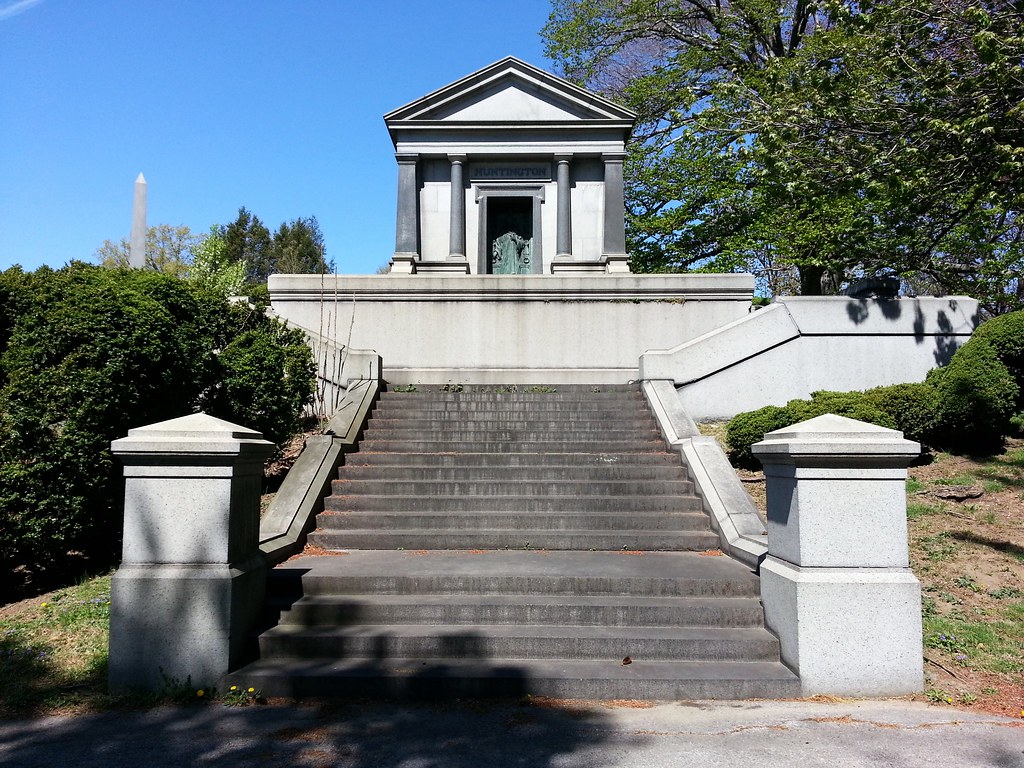
of Collis P. Huntington, the powerful 19th-century railroad magnate (and, as we recently learned, primary benefactor of the Huntington Free Library). About Mr. Huntington's relentless pursuit of his goals, his biographer wrote:
He was that kind of fighter, a slugger lacking in what might be called peripheral moral vision. He saw only what was necessary for success. Huntington did not see qualifying ifs, ands, or buts . . . In the milieu of cutthroat competition, he was unyielding, tireless, ruthless and fertile of stratagems.(Here's a closer look at that intriguing door.)
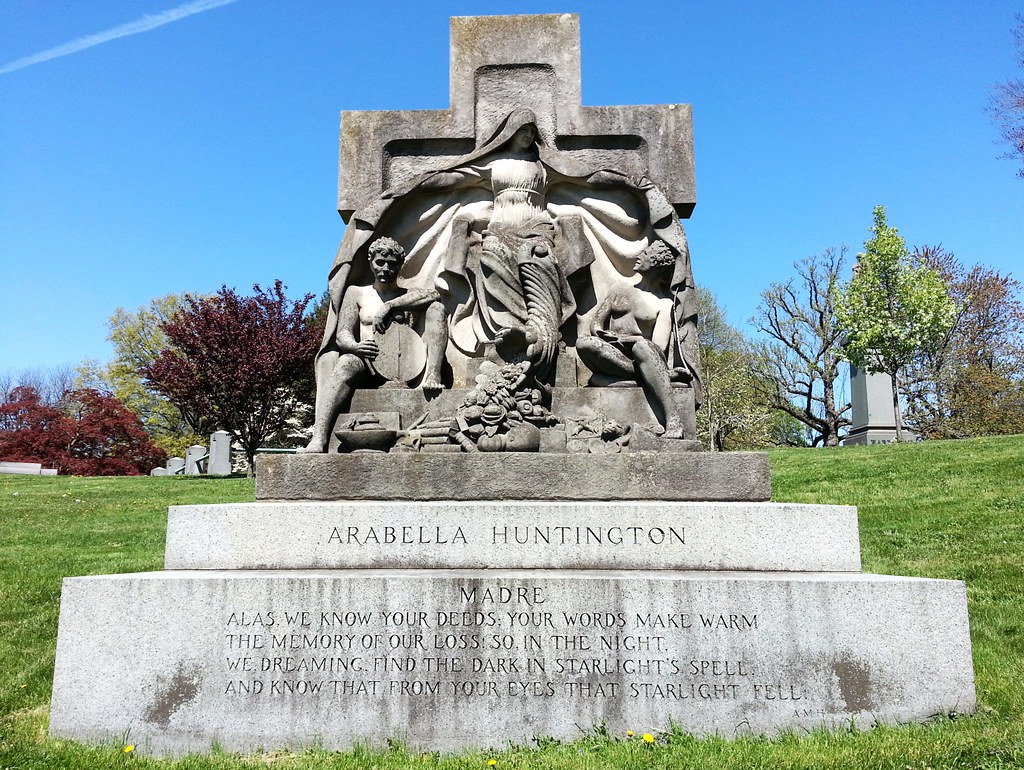
The second wife of Collis P. Huntington (musta been quite a catch), Arabella rose from humble roots in Richmond, Virginia to become "the richest woman in the world" when she inherited a massive chunk of Huntington's fortune upon his death.
She later married her former husband's nephew, Henry E. Huntington, an influential businessman who played an important role in the development of Southern California. Henry and Arabella, under the guidance of a trusted dealer, amassed a tremendous collection of artwork, which they later deeded to the public along with Henry's extensive library and the rest of their estate in San Marino, California, forming the institution now known as the Huntington. Henry and Arabella were buried on the property in a mausoleum designed by John Russell Pope that bears more than a passing resemblance to a later, more well-known creation of his: the Jefferson Memorial. (Arabella's monument here in Woodlawn is merely a cenotaph.)
While researching Mrs. Huntington, I found an NY Times article from 1902 about "an exciting automobile chase" that she was involved in. The "large black machine" in which she was riding blew past a policeman on the streets of Harlem and then
fairly bounded away and it swung at a tremendous pace westward through One Hundred and Twentieth Street into Mount Morris Park West, north along that short, broad thoroughfare to One Hundred and Twenty-fourth Street and on up Fifth Avenue. As it dashed across One Hundred and Twenty-fifth Street it came so near to a collision with a crowded car that spectators held their breath. The course was laid straight up the avenue, but [Officer] Hanley was gradually . . . gaining on the automobile.At a jammed-up 135th Street, Officer Hanley finally caught up to Mrs. Huntington's machine — on his bicycle. He estimated that her driver had been flying up Fifth Avenue at the blazing speed of 17 miles per hour. He dutifully hauled the driver into the station house over Mrs. Huntington's protestations, but she was able to bail him out immediately and continue on her way to her country house in the Bronx.
(Interestingly, Arabella wasn't the only member of the Huntington family to be written up in the Times that year for traveling in a speeding automobile. See "Prince Hatzfeldt Fined For Motor Scorching". Spoiler alert: 30 miles an hour!)
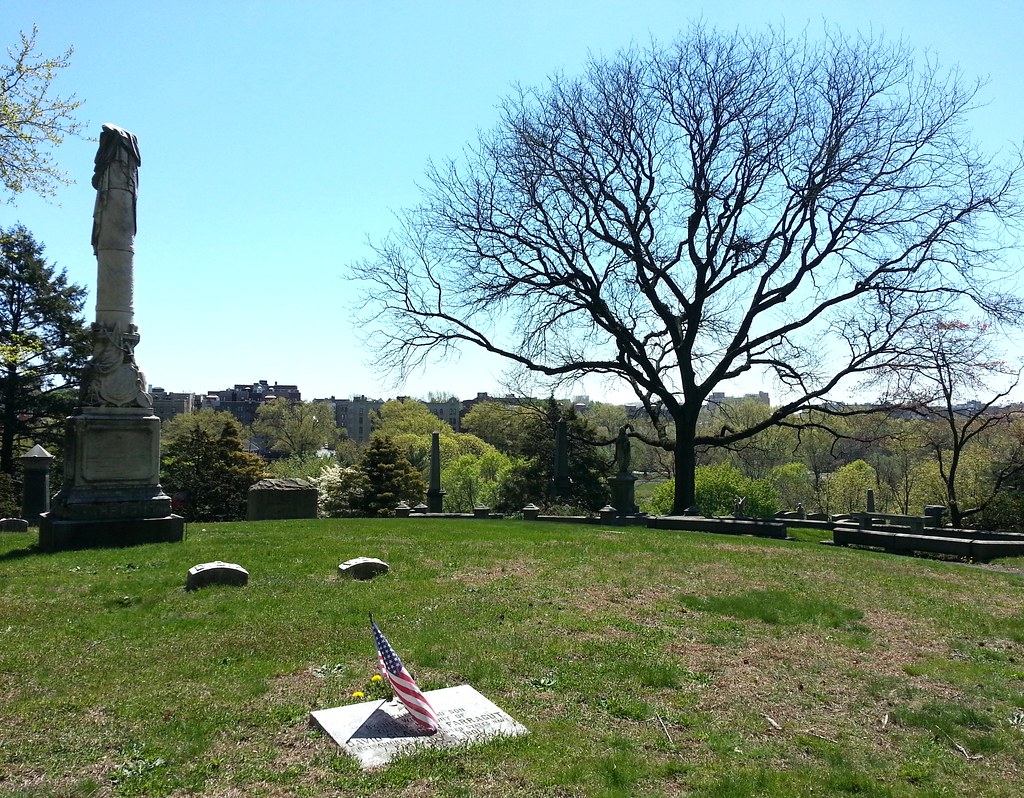
Recently designated a National Historic Landmark (one of 112 in NYC), this is the gravesite of David Farragut, the US Navy's first admiral. (His adoptive brother, David Dixon Porter, was the second.)
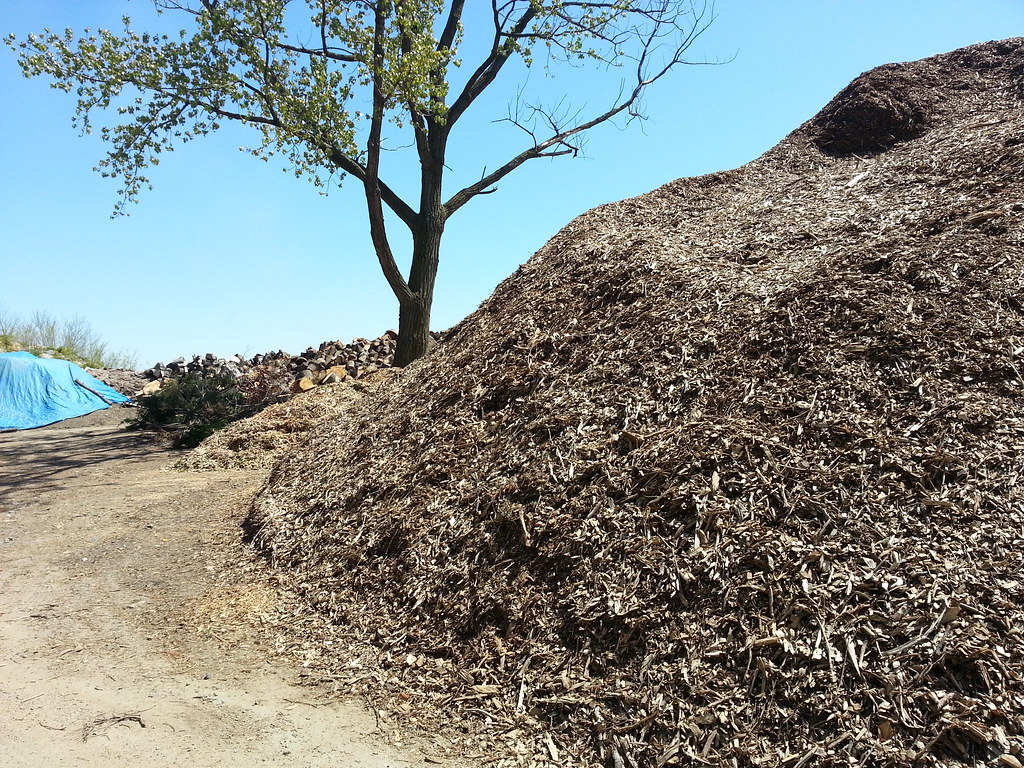
Here at Woodlawn, they're still dealing with the aftermath of Hurricane Sandy. Today I saw a crew taking down yet another tree (or maybe just some of its branches). It sounds like Green-Wood was hit the hardest of all the city's cemeteries, though.
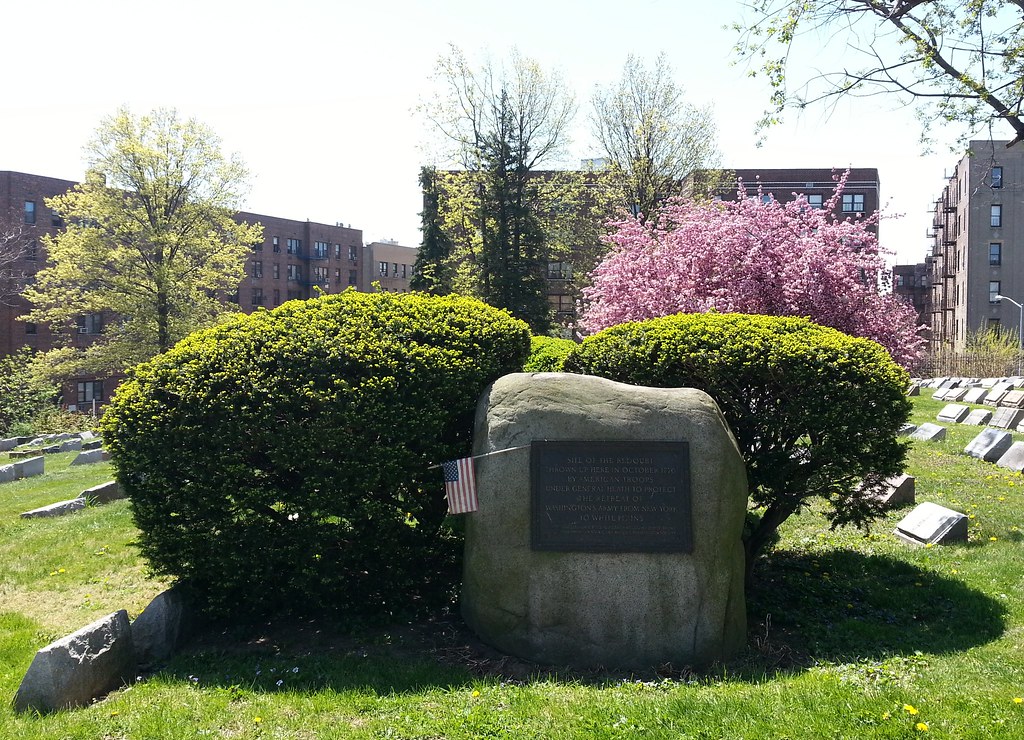
"Site of the redoubt thrown up here in October, 1776 by American troops under General Heath to protect the retreat of Washington's army from New York to White Plains"
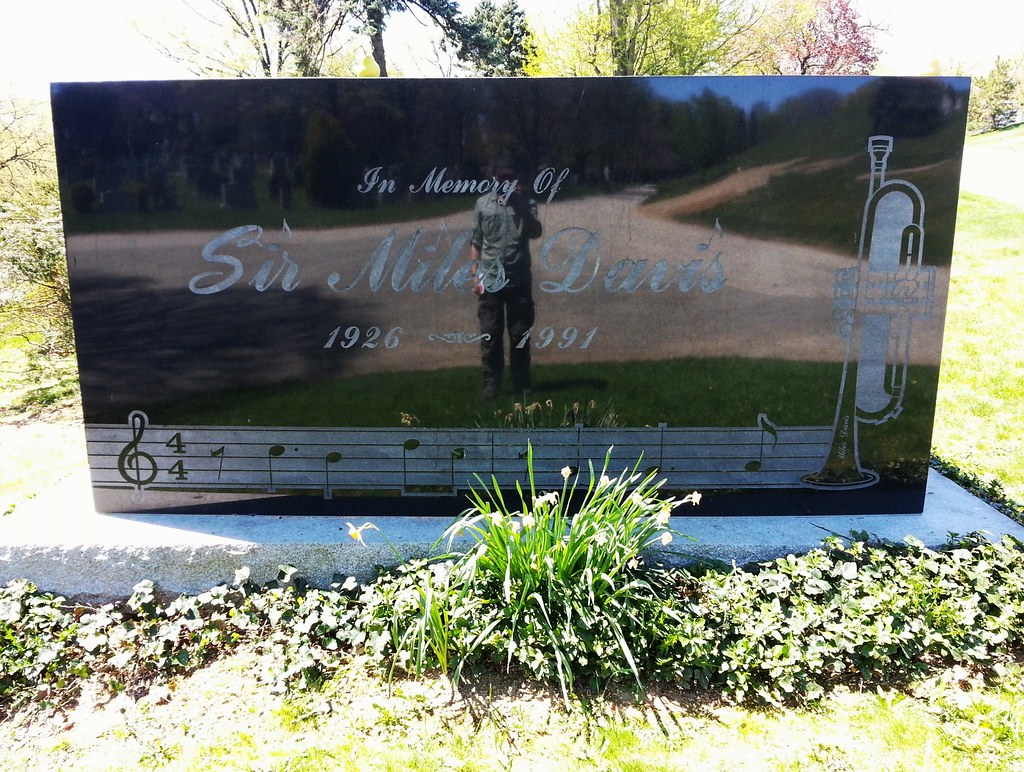
Woodlawn's "jazz corner" (see next post) began to take shape back in 1992, when Miles was laid to rest near the Duke. Here's what the co-author of Davis's autobiography had to say about the two great musicians spending eternity together:
Their spirits are running back and forth . . . They probably got all the worms and everybody doing it. Two people like that together, the energy force of the spirits, the ancestral spirits and their own genius must be too heavy. There must be some heavy stuff.In case you were wondering, and even if you weren't, those are the first two measures of "Solar" engraved on the stone. While searching for a recording of that tune, I found Davis's beautiful rendition of a song that has been a favorite of mine ever since I walked through Wisconsin.
(For the record, this is not the only Miles Davis monument that can be found in the Bronx.)
(Also, for the record, someone had left Miles an offering of two pears on top of his headstone.)

Illinois Jacquet. Also buried here at Woodlawn's "jazz corner" are Lionel Hampton and Max Roach, and the graves of many other jazz greats, such as W.C. Handy and Coleman Hawkins, can be found scattered throughout the cemetery as well. Roach's headstone is inscribed with the last of the 10 free-form haikus that Sonia Sanchez composed for the legendary drummer after his death:
your hands
shimmering on the
legs of rain

Celia Cruz's mausoleum, which she shares with her late husband, was designed to accommodate her loyal following. There are clear windows on the sides, allowing people to peer in, and "someone comes in on a regular basis, cleans it out and changes the photos so there’s always something for the fans to see."
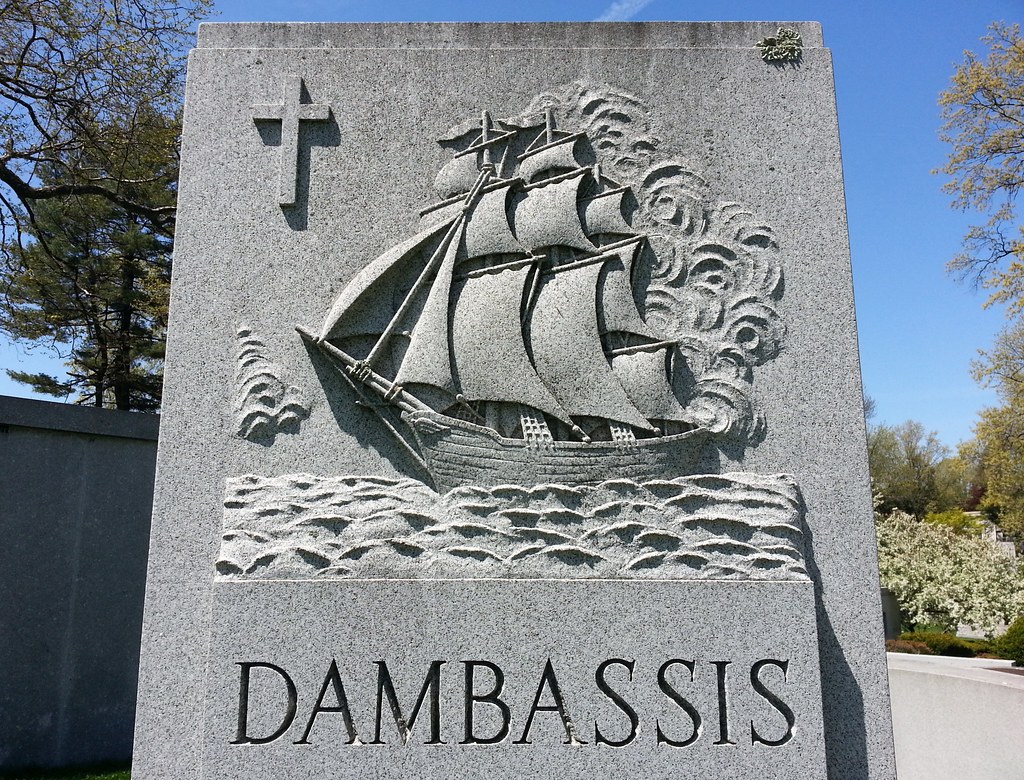
This stone lists the family's patriarch as a "Captain Demosthenes"; perhaps he is the wealthy Greek shipper of the same name mentioned in this 1968 column by Suzy Knickerbocker about that summer's coming-out parties for debutantes in Newport and the Hamptons.
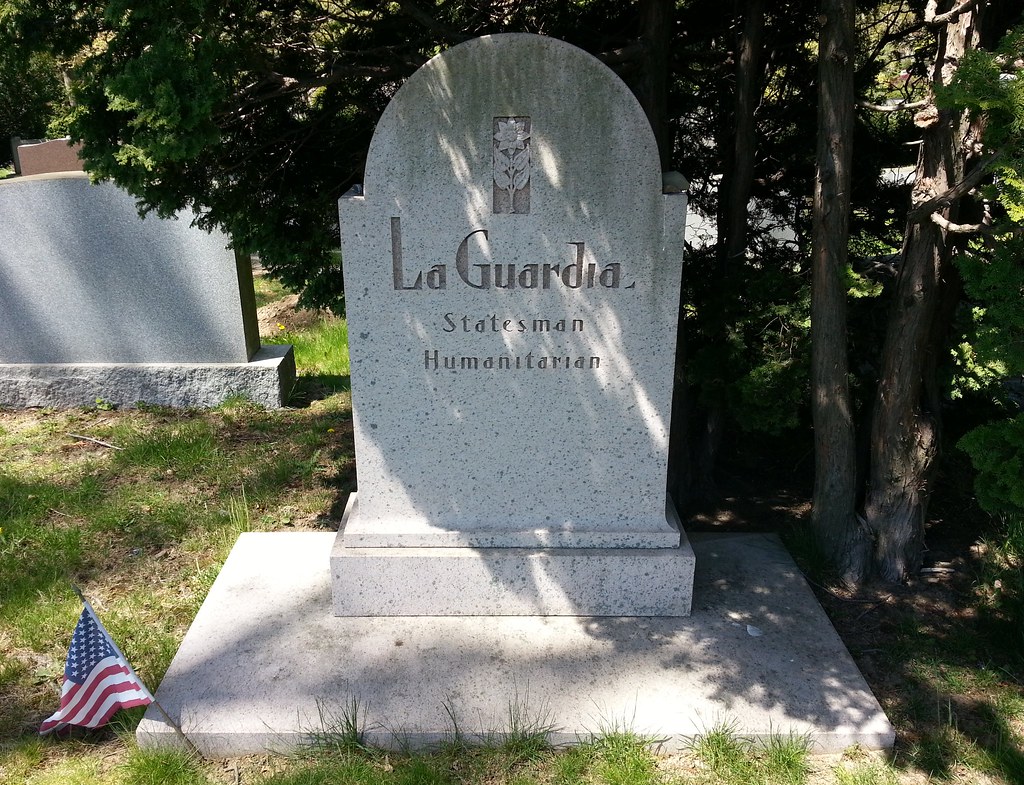
From Mayor La Guardia's 1947 NY Times obituary:
[He] was only about 5 feet 2 inches in height, a rotund little man with a swarthy skin and a belligerent independence that often verged on irascibility. A forelock of black hair invited comparison with Napoleon. His voice was high, and in debate often became a screech. . . .
A crusader all his life in the interests of the underprivileged and the oppressed, the "Little Flower" was a clever showman whose campaigns were always spectacular and whose battles against corruption and special privileges were usually successful. His enemies sometimes called him a demagogue, but to his followers he was a latter-day St. George, bent on slaying the Tammany Tiger rather than the fabled dragon.

About this stone rest the remains of 417 among them early settlers and soldiers of the colonial and national wars, interred 1664-1908 in Nagel Cemetery, West 212th Street Manhattan, the site of which was covered by a vast public improvement [the 207th Street subway yard]. Reinterred here 1926-1927 by the City of New York.
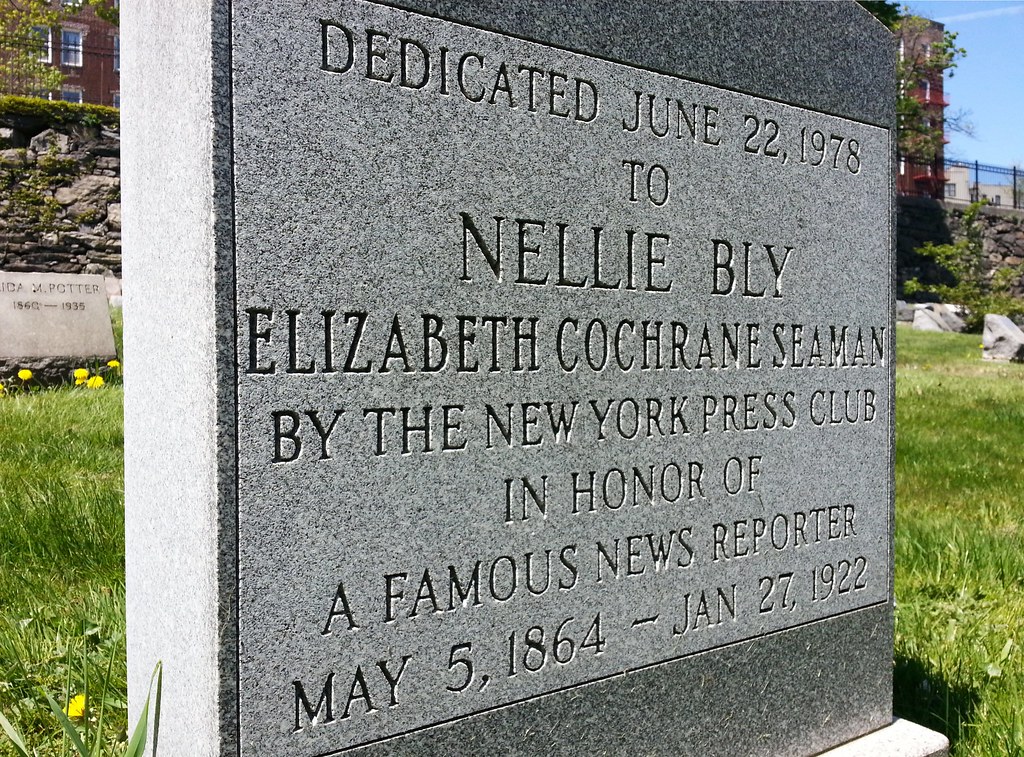
Nellie Bly "remains notable for two feats: a record-breaking trip around the world in emulation of Jules Verne's character Phileas Fogg, and an exposé in which she faked insanity to study a mental institution from within."
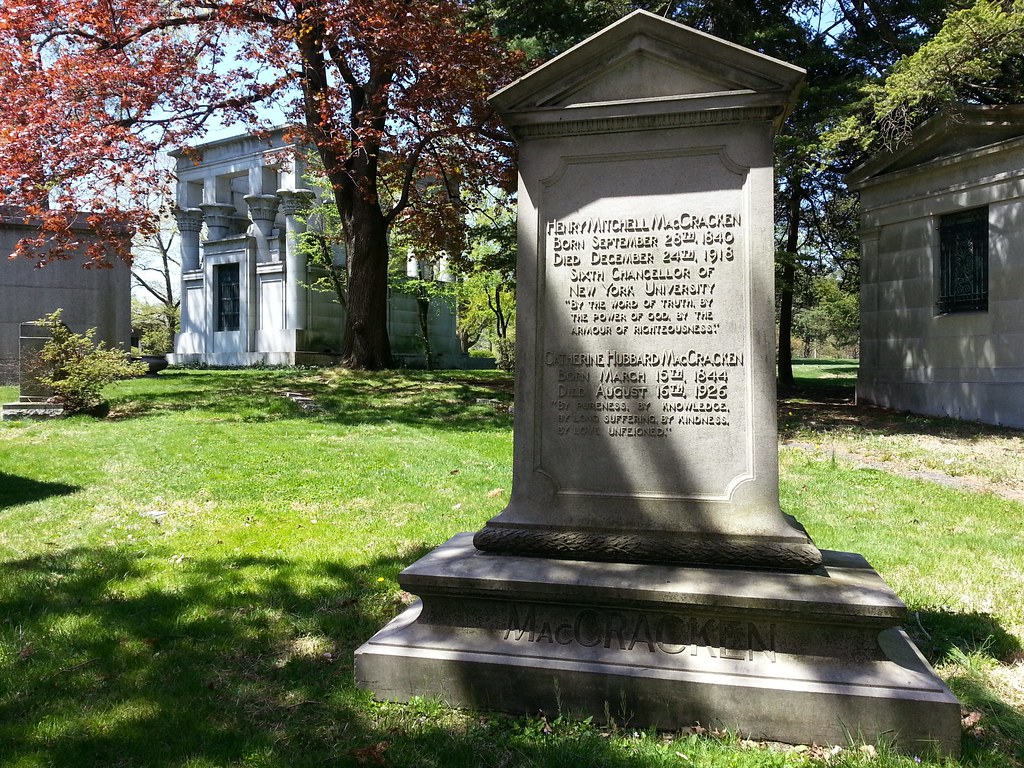
As chancellor of NYU, he was the driving force behind the creation of the Hall of Fame for Great Americans, now one of the city's most wonderful forgotten treasures. But far more importantly, he's the first character we've come across whose beard has a fighting chance of besting Peter Cooper's.

This prominent banker's remains are entombed inside a replica of Trajan's Kiosk.
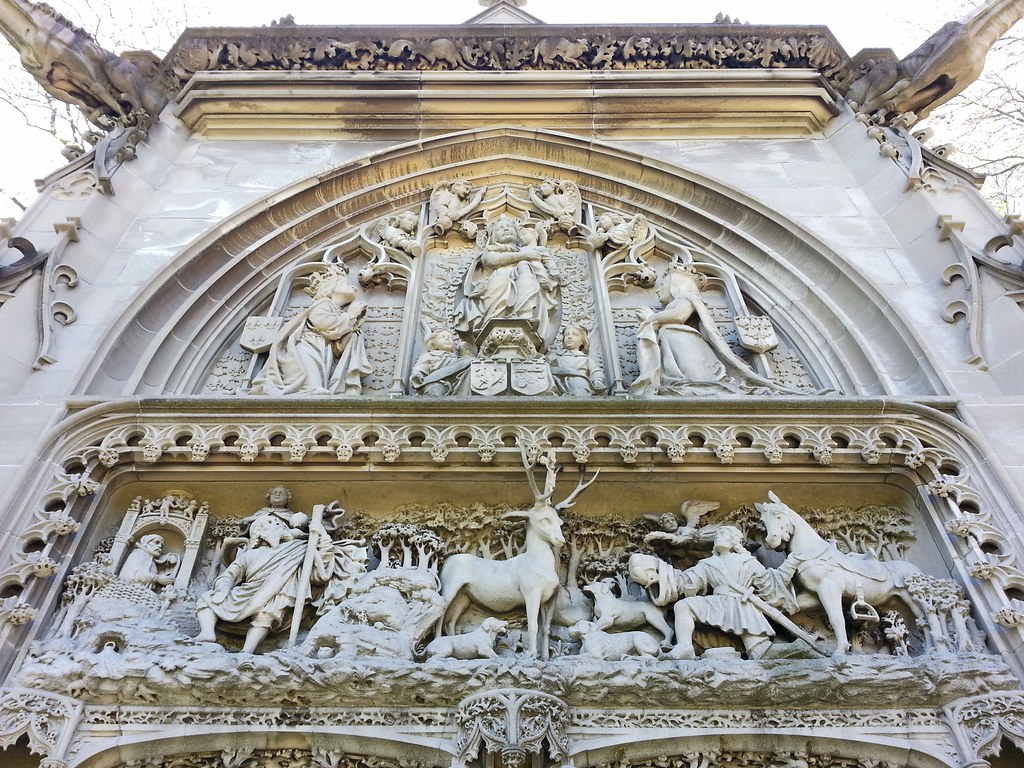
This replica of the Château d'Amboise's chapel of St. Hubert (where Leonardo da Vinci's remains are supposedly interred) is the final resting place of Alva and Oliver Belmont.
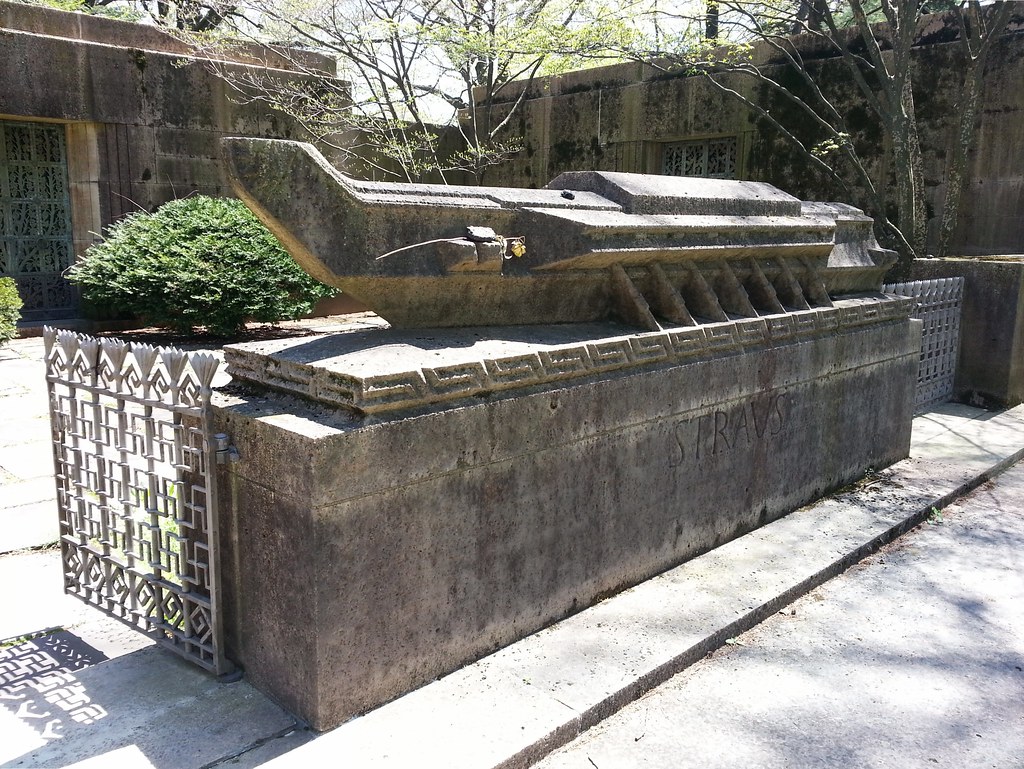
This is the tomb of Isidor Straus, a former congressman and co-owner of Macy's, and the cenotaph of his wife Ida. The couple died aboard the Titanic after Isidor passed up a lifeboat seat, seeing that there were still women and children on the ship, and Ida refused to leave his side. Isidor's body was later recovered, but Ida's was never found. The other side of the monument is inscribed with a line from the Song of Songs: "Many waters cannot quench love, neither can the floods drown it".




